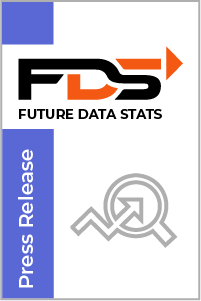
AI in Agriculture Market to Reach USD 8.15 Billion By 2030 | CAGR: 24.1%
The global Artificial Intelligence in Agriculture market size is expected to reach USD 8.15 billion by 2030, registering a compound annual growth rate (CAGR) of 24.1% during the forecast period, according to a new report by Future Data Stats.
The integration of Artificial Intelligence (AI) in the agriculture sector has led to remarkable growth and transformative trends, revolutionizing the way farming practices are conducted. This technological evolution has empowered farmers and agribusinesses with innovative tools and solutions thatenhance productivity, sustainability, and resource management. The Artificial Intelligence in Agriculture market has witnessed significant expansion, driven by its potential to address key challenges in the industry while also improving the overall efficiency of agricultural operations. This essay delves into the growth trajectory and prevailing trends within this market, highlighting important segments and their respective contributions.
The growth of the Artificial Intelligence in Agriculture market can be attributed to the pressing need for increased food production to meet the demands of a growing global population. Conventional agricultural practices often face limitations in terms of yield optimization, resource utilization, and response to changing environmental conditions. AI technologies have emerged as a transformative force by offering data-driven insights, predictive analytics, and automation capabilities. These aspects have facilitated informed decision-making, precise resource allocation, and streamlined processes, ultimately resulting in enhanced crop yields and improved operational efficiency.
One of the prominent trends in the market is the adoption of AI-driven analytics and predictive modeling. Farmers and agribusinesses are leveraging AI to process vast amounts of data collected from various sources such as sensors, satellites, drones, and weather stations. This data is then analyzed to generate actionable insights regarding soil health, crop growth patterns, disease prediction, and pest infestations. By identifying potential issues before they escalate, AI empowers farmers to implement timely interventions, minimizing crop losses and optimizing resource allocation.
Segmentation within the Artificial Intelligence in Agriculture market is a vital aspect that reflects its diverse applications. One of the key segments is precision farming, where AI technologies are employed to create digital maps of fields, enabling variable-rate applications of seeds, fertilizers, and pesticides. This approach optimizes resource usage by tailoring inputs to specific areas of the field, leading to improved yield consistency and reduced environmental impact. Additionally, AI-driven robotic systems fall under another segment, automating labor-intensive tasks such as planting, weeding, and harvesting. These robots operate with a high degree of accuracy, ensuring optimal plant spacing and minimizing damage to crops.
The livestock monitoring segment within the AI in Agriculture market is also gaining momentum. AI-powered sensors and wearable devices track the health and behavior of animals in real time. By analyzing data patterns, farmers can detect signs of illness or distress early, allowing for prompt veterinary intervention and preventing disease outbreaks. This not only improves animal welfare but also safeguards farmers' investments.
Water management constitutes another crucial segment wherein AI aids in optimizing irrigation practices. By analyzing soil moisture levels, weather forecasts, and crop water requirements, AI algorithms determine the precise amount of water needed and when to irrigate. This conserves water resources and prevents over- or under-irrigation, which can lead to crop stress or wastage.
The deployment of AI-powered drones and satellites for remote sensing is a trend that is shaping the future of precision agriculture. These technologies capture high-resolution imagery of fields, providing valuable insights into crop health and growth. AI algorithms process this data to identify areas with nutrient deficiencies, pest infestations, or disease outbreaks. Subsequently, farmers can take targeted actions, such as applying fertilizers or pesticides only where needed, reducing input costs and environmental impact.
Artificial Intelligence In Agriculture Market Report Highlights
- The increasing demand for food production, the rising labor costs, and the need to improve crop yields are driving the growth of the market.
- AI is being used to automate tasks, improve decision-making, and optimize resources in agriculture.
- Some of the key AI technologies used in agriculture include machine learning, computer vision, and predictive analytics.
- The precision farming, drone analytics, and agriculture robots segments are the major segments of the AI in agriculture market.
- North America is the largest market for AI in agriculture, followed by Europe and Asia Pacific.
- Some of the leading players in the AI in agriculture market include IBM, Microsoft, John Deere, and Bayer.
Top Leading Players
- IBM Corporation
- Microsoft Corporation
- John Deere
- The Climate Corporation (a subsidiary of Bayer)
- Ag Leader Technology
- Agribotix LLC
- Granular (a subsidiary of Corteva Agriscience)
- Taranis
- Trimble Inc.
- Descartes Labs
- Gamaya
- Prospera Technologies
Artificial Intelligence in Agriculture Market Segmentation
By Type:
- Machine Learning
- Computer Vision
- Predictive Analytics
- Natural Language Processing
By Application:
- Crop Monitoring
- Precision Farming
- Livestock Monitoring
- Agricultural Robots
- Soil Management
- Disease Detection
- Yield Prediction
- Supply Chain Management
By Technology:
- Drone Technology
- Satellite Imaging
- Sensors and IoT Devices
- Robotics
By Geography:
- North America (USA, Canada, Mexico)
- Europe (Germany, UK, France, Russia, Italy, Rest of Europe)
- Asia-Pacific (China, Japan, South Korea, India, Southeast Asia, Rest of Asia-Pacific)
- South America (Brazil, Argentina, Columbia, Rest of South America)
- Middle East and Africa (Saudi Arabia, UAE, Egypt, Nigeria, South Africa, Rest of MEA)
- Consulting Services
- Tailored Insights
- Syndicated Market Research
- Competitive Intelligence
- Emerging Technologies
- Customer Research
- Market Intelligence
- Industry Development
Our Clients











USA: +1 2345-6789
help@fds.com



